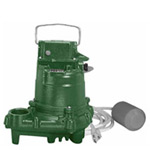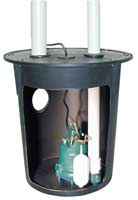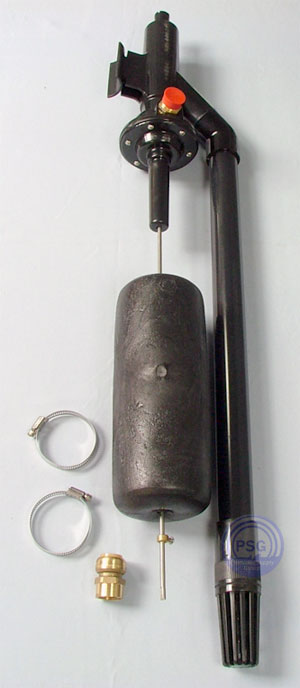Sometimes you need help choosing the right type of pump. Sometimes you need help determining the size of a pump. And sometimes, you just have basic questions. Below, you’ll find our answers to some of the most frequently asked questions about pumps.

Q: “I would like to add a toilet in my basement, but all my drain lines are above. I need to be able to pump the sewage UP. What can I do?”
A: You’ll have to check with a plumber for what the options are in your particular home, but in many cases, a macerating toilet or grinder pump can be installed with very little fuss. Many units can also deal with wastewater from sinks, showers and tubs, making it that much easier to have a full-on bathroom wherever you need it.
Q: “What is the difference between a sewage ejector pump and a grinder pump?”
A: A sewage ejector pump has impellers that enable the pump to pass a predetermined size of solid matter without clogging the discharge. These are most often used when waste does not need to travel a great distance to the main drain line. A grinder pump has cutter blades that macerate and shear waste solids. The resulting “slurry” is easier to transport through standard pipe over long distances, making these the preferred choice when the main drain is located further up and/or away.
Q: “How does a compact grinder pump work?”
A: The compact grinder pump uses scissor-cutting action to grind and cut the waste into a fine slurry which then allows it to pass through the unit’s discharge line to the main drain.

Q: “What’s the difference between an automatic and non-automatic pump?”
A: An automatic pump has a built-in float switch that will turn on the pump automatically at a fixed water level. After the water is pumped out to certain water level (also preset), the pump will turn itself off. A non-automatic pump has to be manually turned on and off, or use a separate control like a piggyback float switch.
Q: “My automatic pump stops and starts constantly, how can I make the pump run longer?”
A: This “short-cycling” is a function of the basin diameter and the “on/off” pumping range, and can decrease the service life of a switch assembly. Since the basin is in the ground, it is unlikely that it can be enlarged. And if you have an automatic unit which has a self contained float switch, the “on/off” pumping range cannot be adjusted. But with a non-automatic switch-controlled unit, you can have flexibility in the pumping range adjustment. If this occurs, an automatic unit can be converted to operate with an external pump switch, which will expand its pumping range and decrease the amount of short cycling. Installing a check valve in the discharge line will also help decrease short-cycling in most cases.
Q: “How does a VLFS (variable level float switch) work?”

A: The pumps that come with a variable level float switch are non-automatic pumps. You just attach the float switch and the pump will behave like an automatic pump. However, the VLFS allows you to specify the water level (between 6” and 36”) that will turn the pump on/off. This is different than standard automatic pumps with a preset water level that turns them on and off. Since the VLFS is detachable, the pump can also be used as a non-automatic unit whenever needed.
Q. “Anything I should know before purchasing a water powered back-up sump pump system?”
A: Because potable water is directly connected to these sorts of pumps (which could also have non potable water in them), many codes and municipalities require that a special backflow prevention device be installed. The check valve that comes with the HOME GUARD®, for example, is a type of back flow prevention device, but many municipalities and codes do not recognize that style as “approved” (at least at the time of this writing). We recommend you check with your local building department and if required, purchase the appropriate double check valve assembly to go with your pump. We always recommend a double check valve, but at the very least, install a quality 3/4” swing or spring check valve.
… more questions? Our friends at PlumbingSupply.com can help. Plus, they offer the largest selection of plumbing-related pumps for just about anything!





#
if people would just read that it would save so much time for plumbers
#
I just purchased my first home and it has a drain pump system next to the washer. I’ve never owned one before so I’m not used to them. Are they supposed to run randomly even if I’m not doing laundry?
#
Joana – that could be due to a number of things. If no other appliances are draining to the area and there’s no water present for the pump to be moving, there could be a problem with the controller/switch, or even with the pump itself. We highly recommend contacting the manufacturer, and/or posting about your situation on http://www.plbg.com/ – there are many experts and DIYers there that should be able to shed some light on it.
#
We live in a downstairs condo. The unit upstairs has a drain pipe leak when the faucet in the bathroom sink is on, we can hear the drip in the walls. It has been diagnosed by a licensed plumber. The issue now is where are they going to access the leak. Can they fix it from the source upstairs. We do not want to be inconvenienced again by the negligent owner, who let a toilet and bathtub leak ruin our bathroom and outside laundry area 3 years ago. We would appreciate your thoughts on this and hope all the work can be done upstairs.
#
Hi Art, it will depend on the structure of the building and its plumbing system as to where the leak will be accessible. We recommend consulting the plumber who diagnosed the problem as to the best solution for fixing it, or feel free to post your questions and photos at Plbg.com for free advice from plumbing experts. Thanks for reading!
#
If my pipes are corroded and leaking how does water stay in the drain pipe..and my plumber can’t snake through the clog..
#
Hi Buck. To your first point, I suppose that would depend on the size and location of the leaks. If a clog can’t be snaked, a different cutting head might need to be used, or maybe a hydro-jet. You might get some more helpful answers at http://plbg.com – good luck.
#
I have a fifty foot well and recently the pressure pump started coming on frequently and now stays on unless I manually turn it off. I thought I needed a new pressure pump as it is ten years old but my new plumber said to install a submersible pump. Is this the solution?
#
That would depend on the specifics of your situation. You might try posting over at http://plbg.com – one of the plumbers there may be able to offer some insight! Good luck!
#
It’s great to know that most of the pumps out there can be easily installed with little effort. I will share this information with my mom since the system they have on the farm they bought is not working anymore. It is what made the price go lower when the inspector they hired checked them. Now, they need to get it repaired or replaced if needed so that they can use it to reduce water bill.
#
2000 psi large cylinder, correctly installed (safety in mind– when applying/using this method) threaded fittings, slowly add pressure, yet to see this fail—this will clear line, however when faced with a poor designed/installed plumbing system, this problem will return until plumbing system defects are corrected!
#
I installed a pump system where I added a bathroom, all pee traps are full ,but i get sewage smell when it comes on. I’m pumping in to a septic system. Any advice?